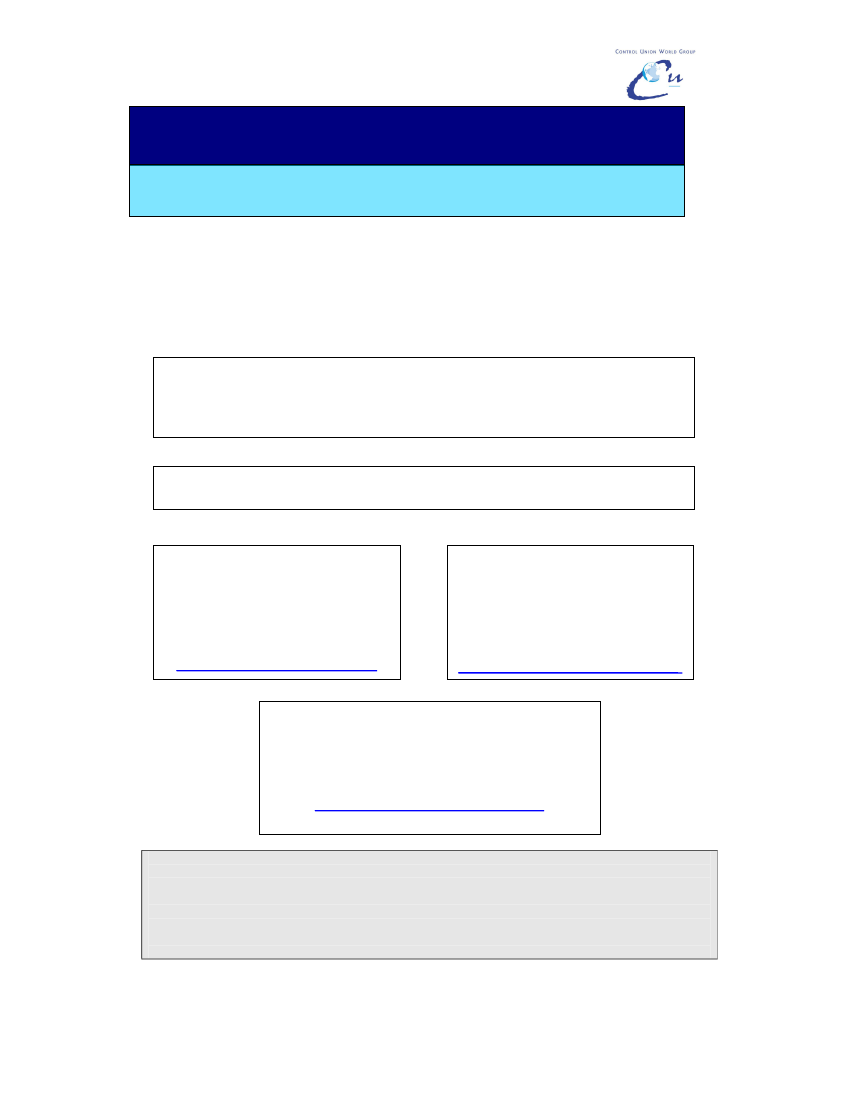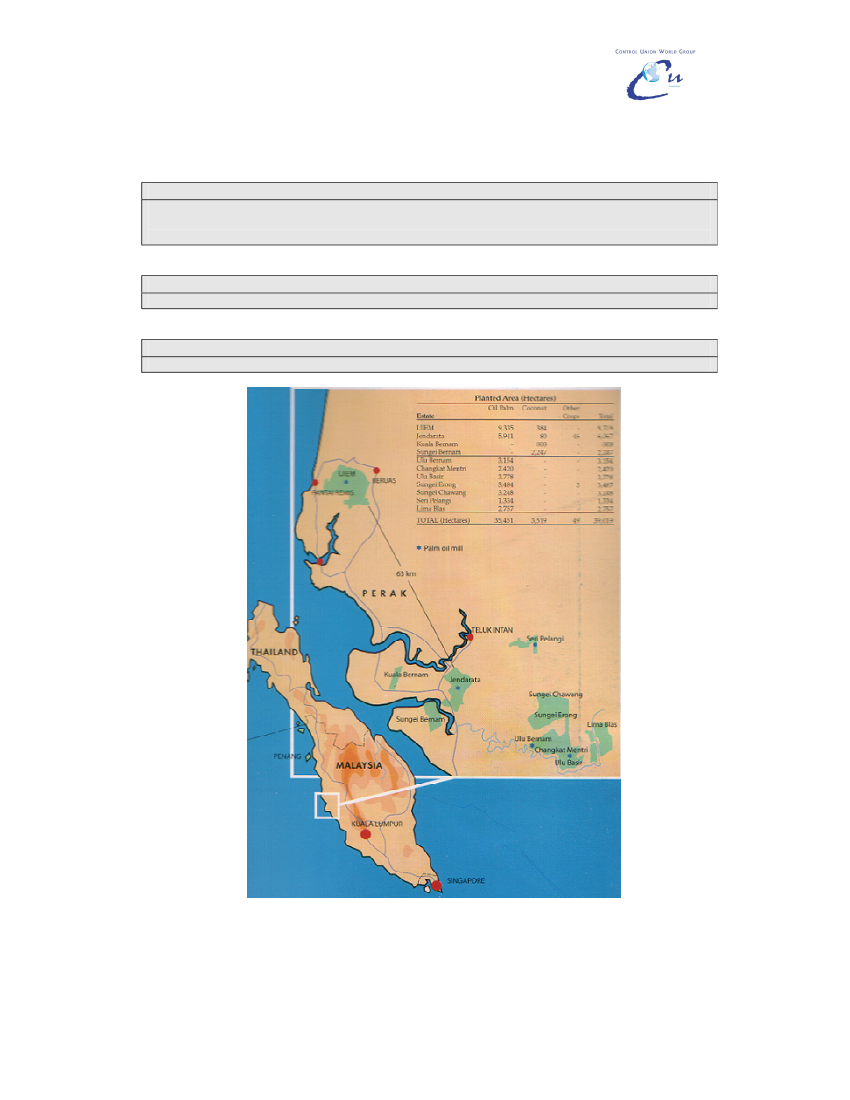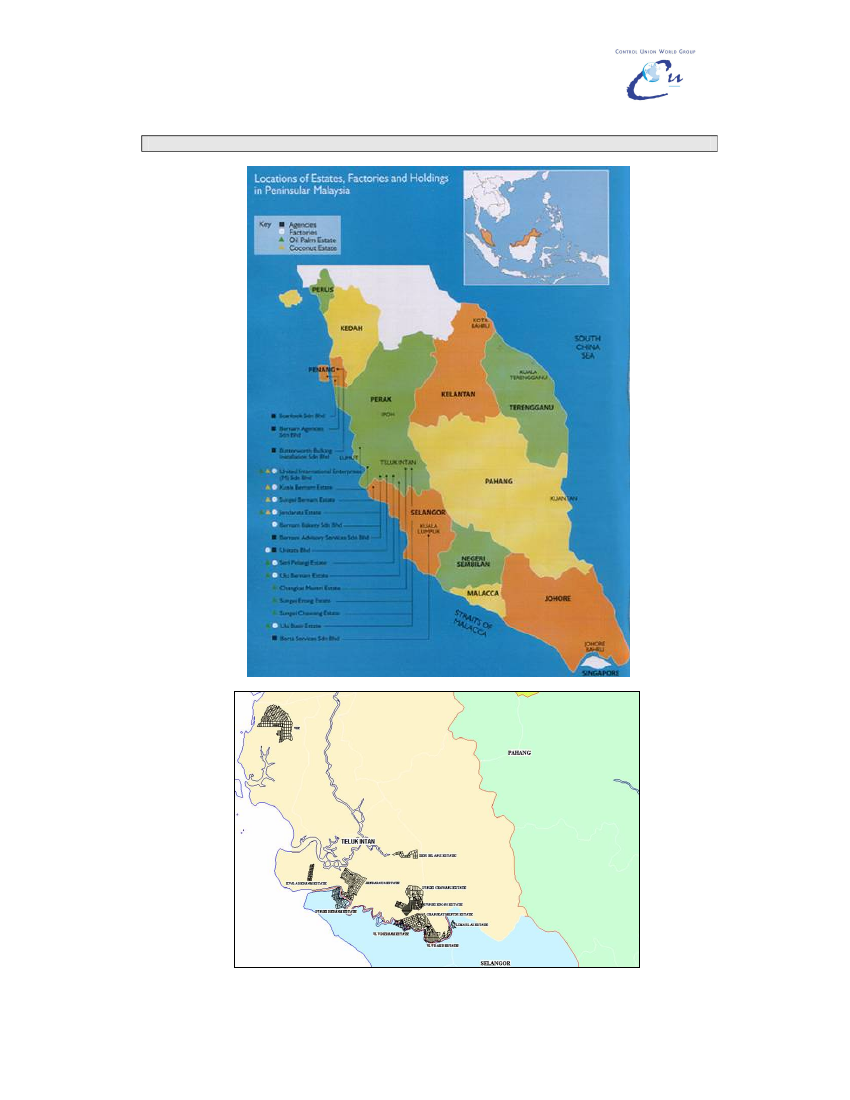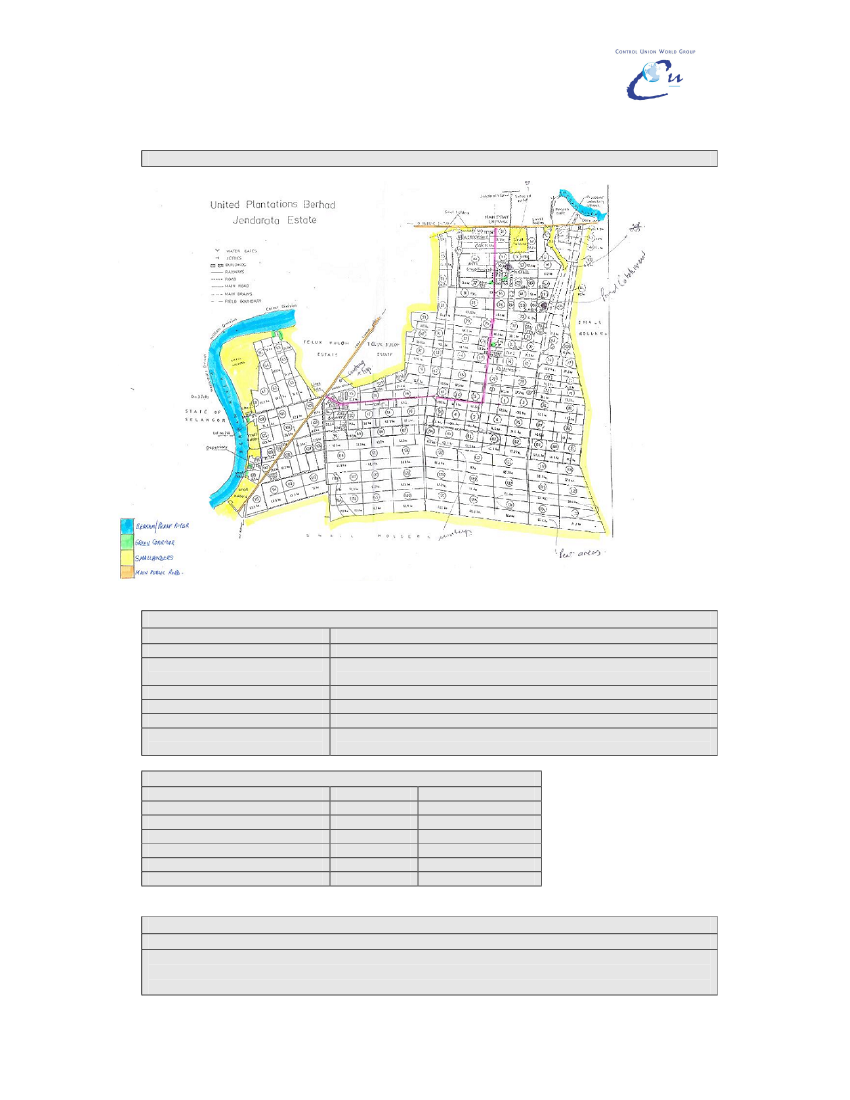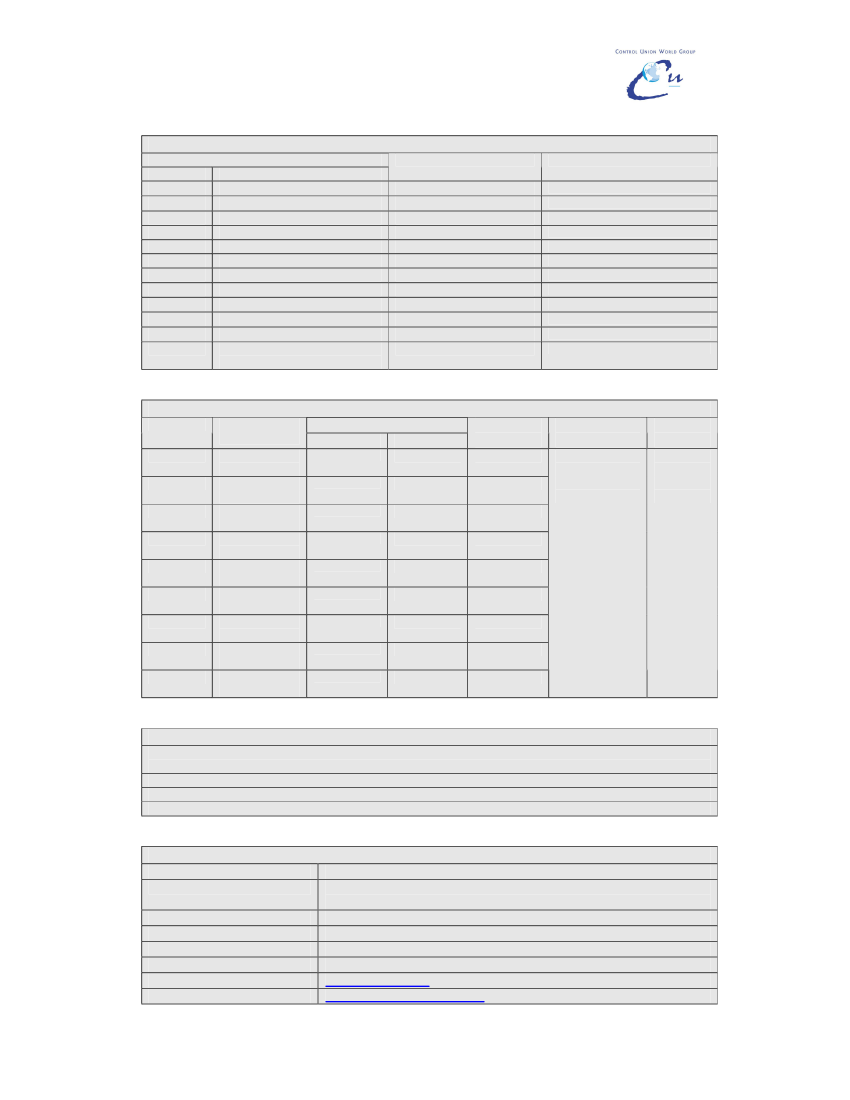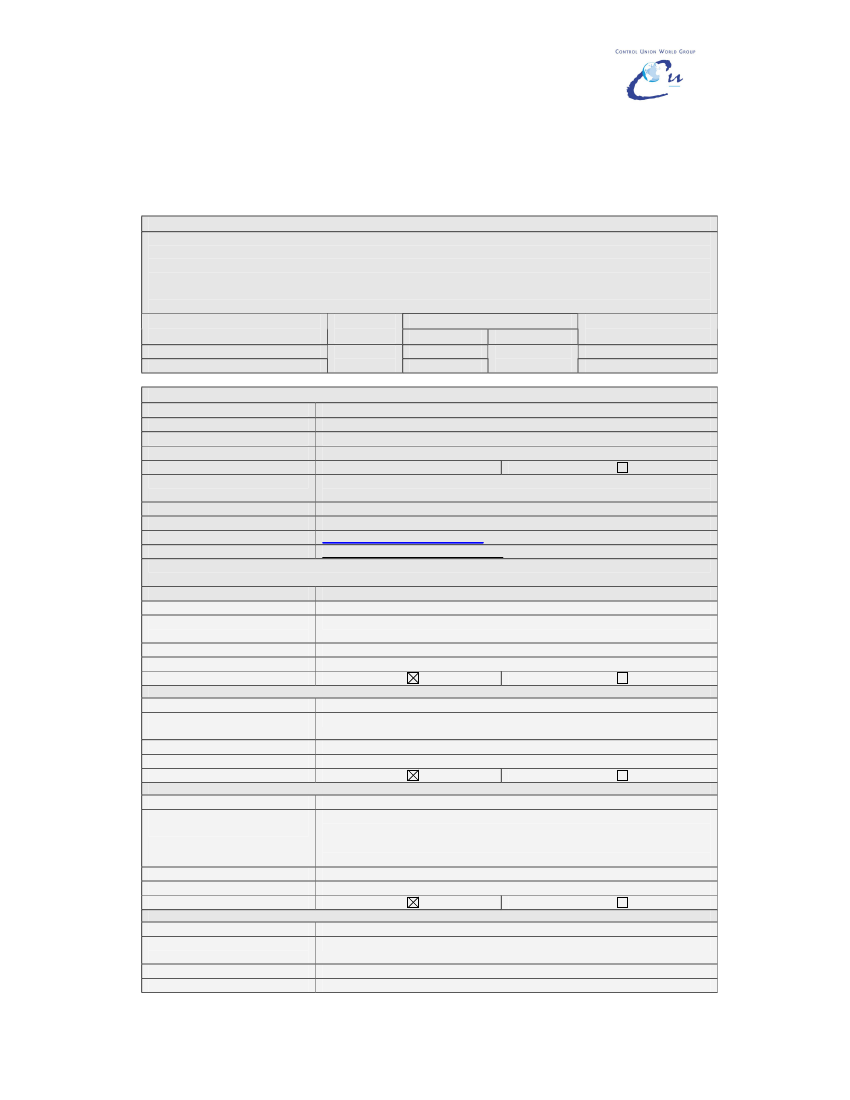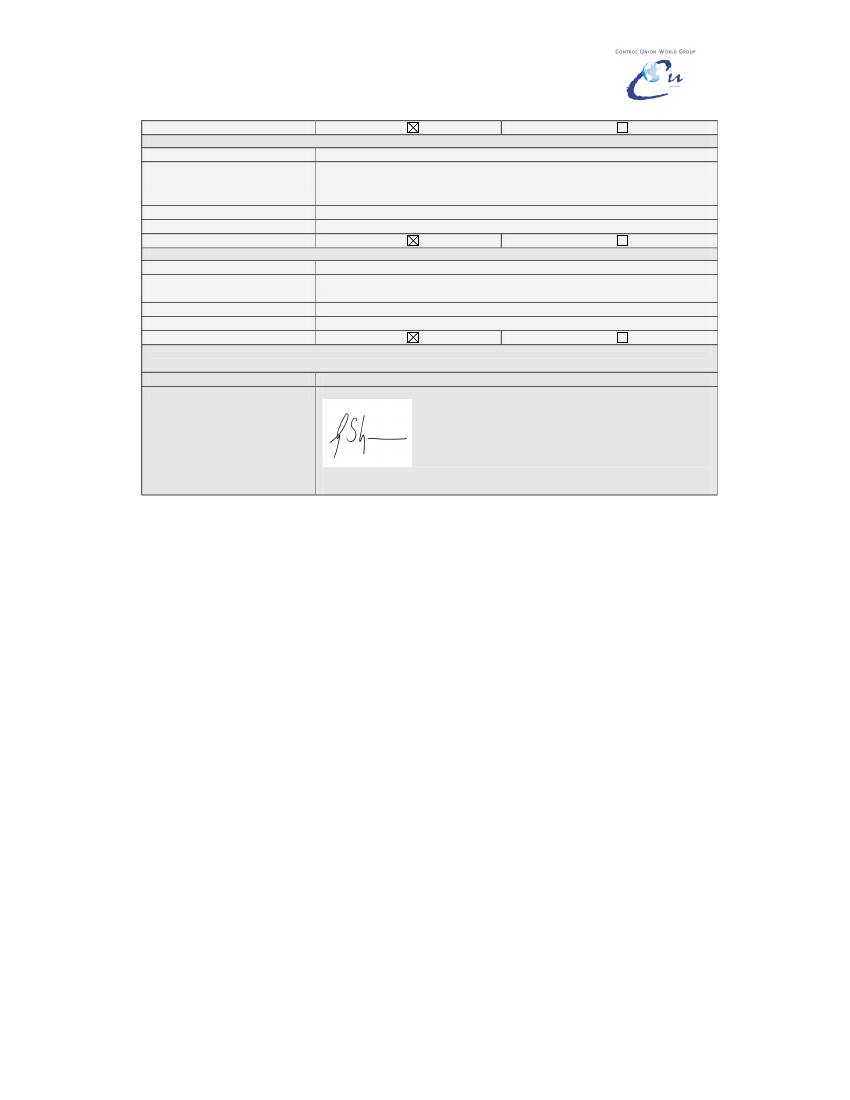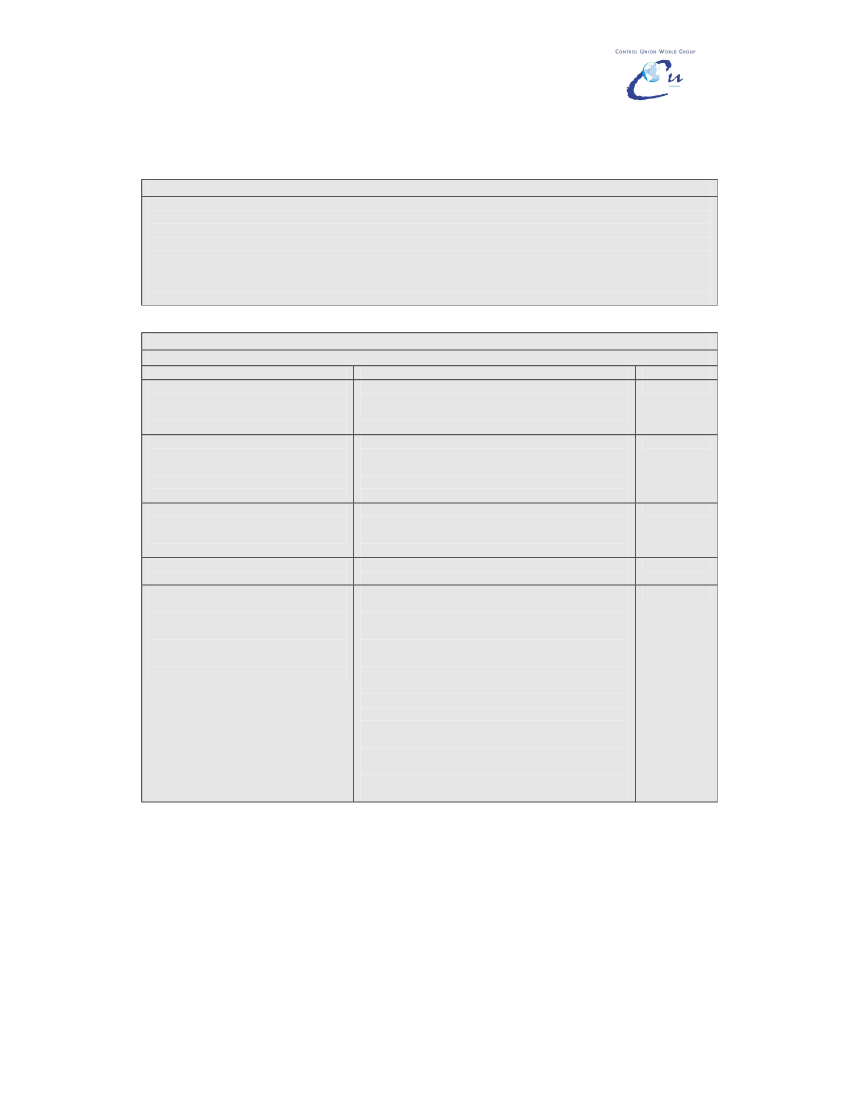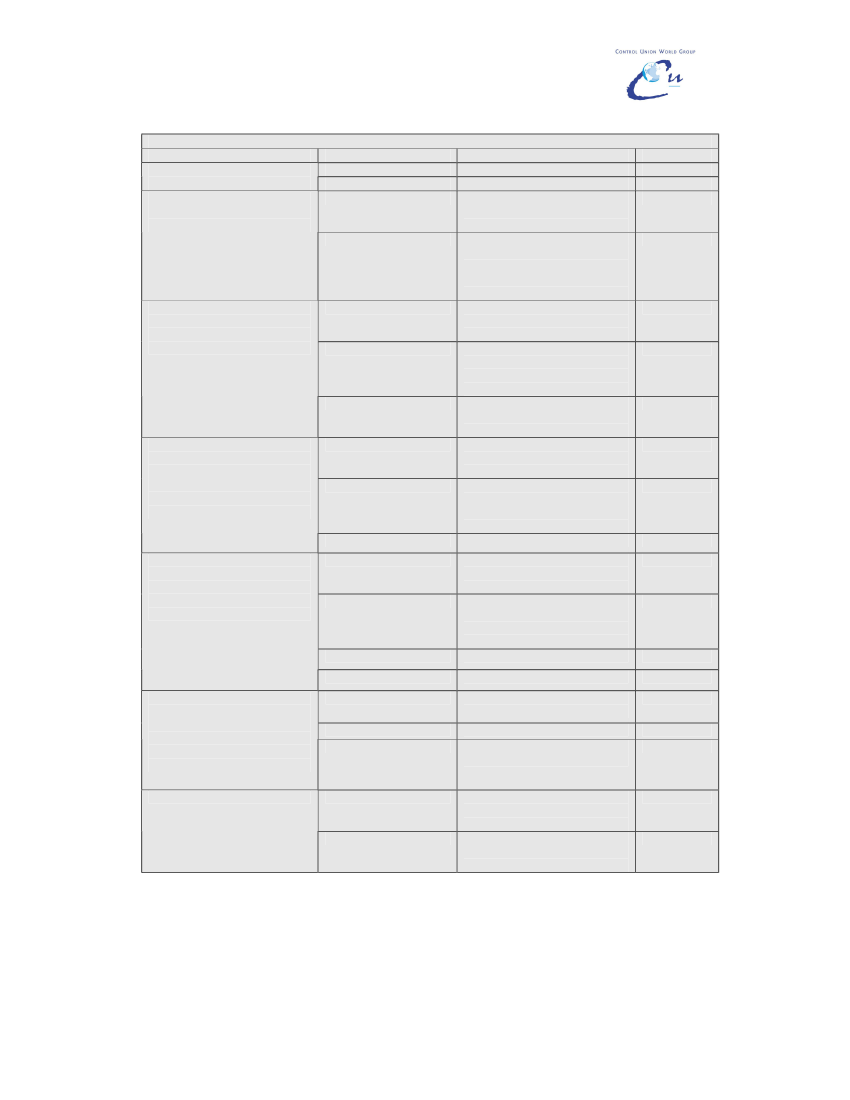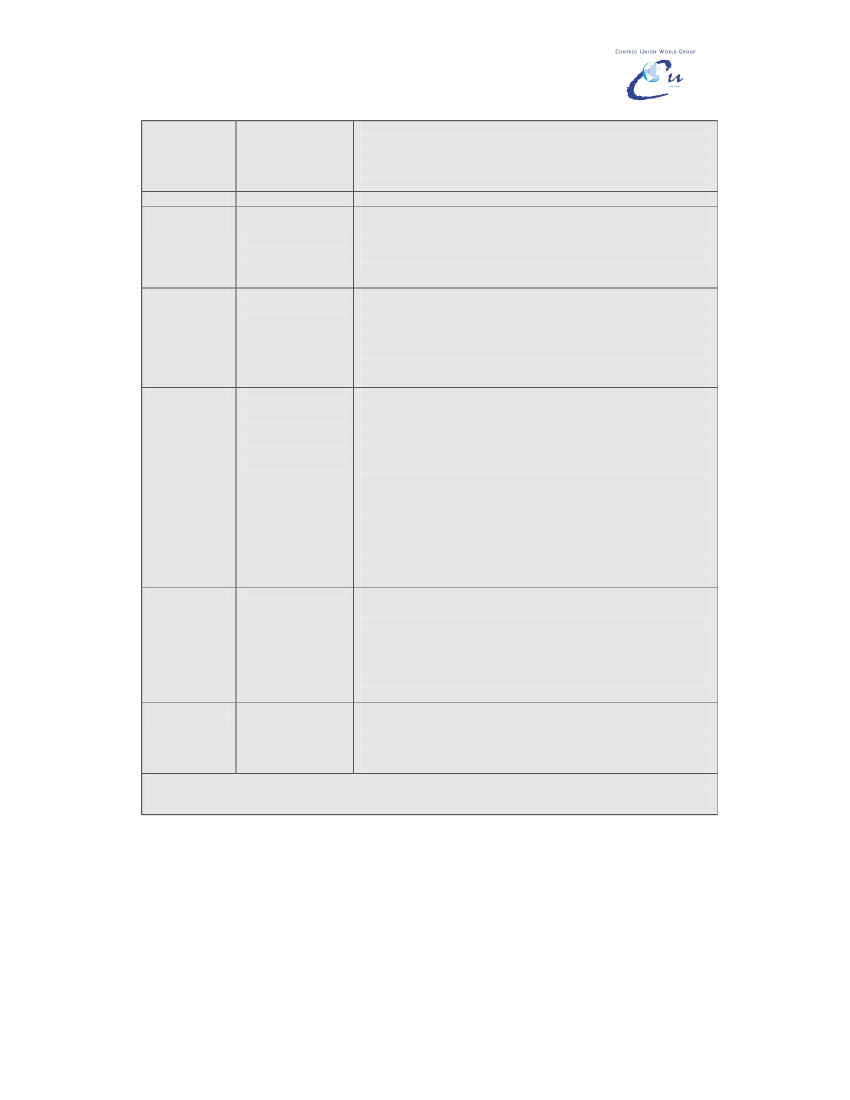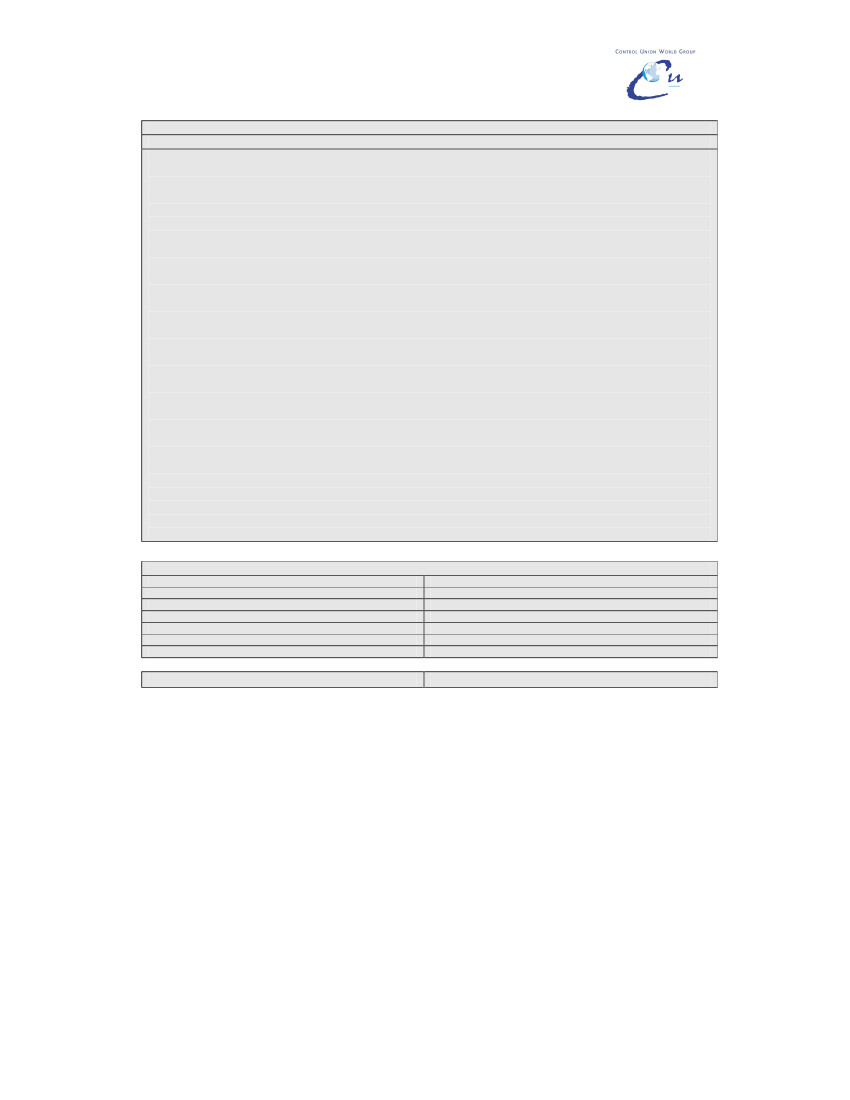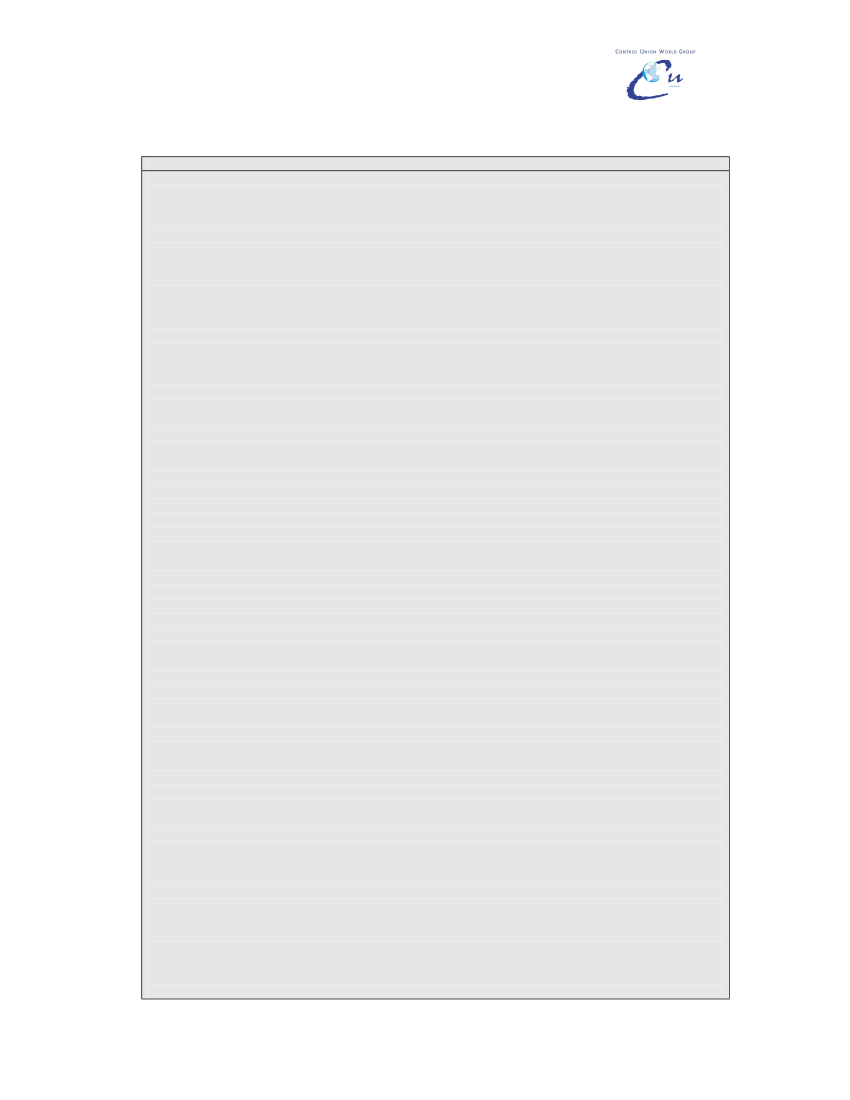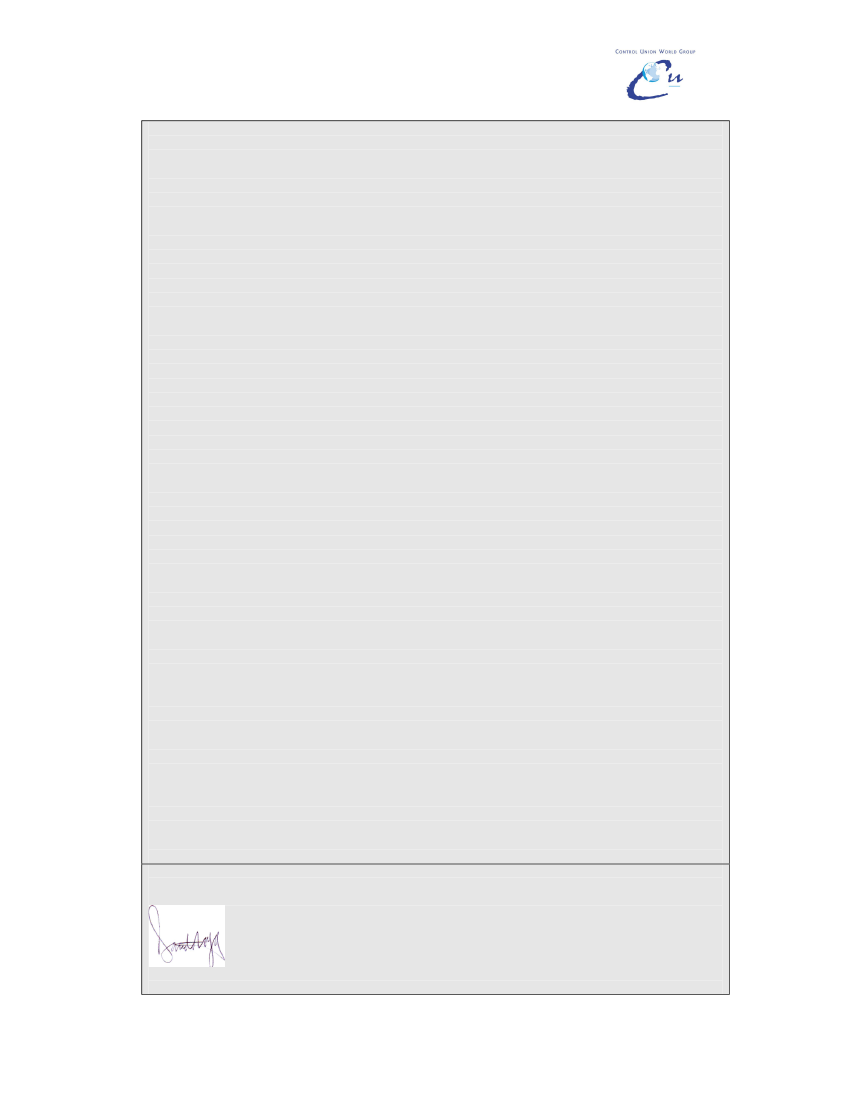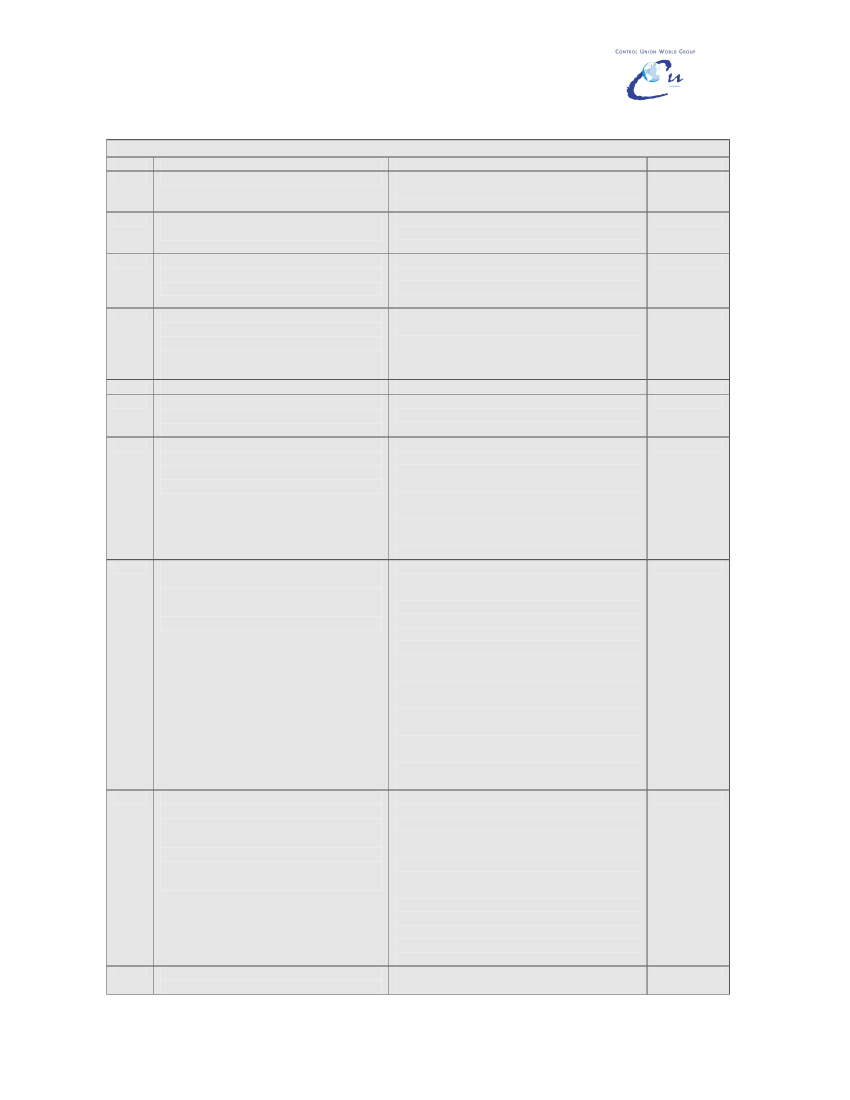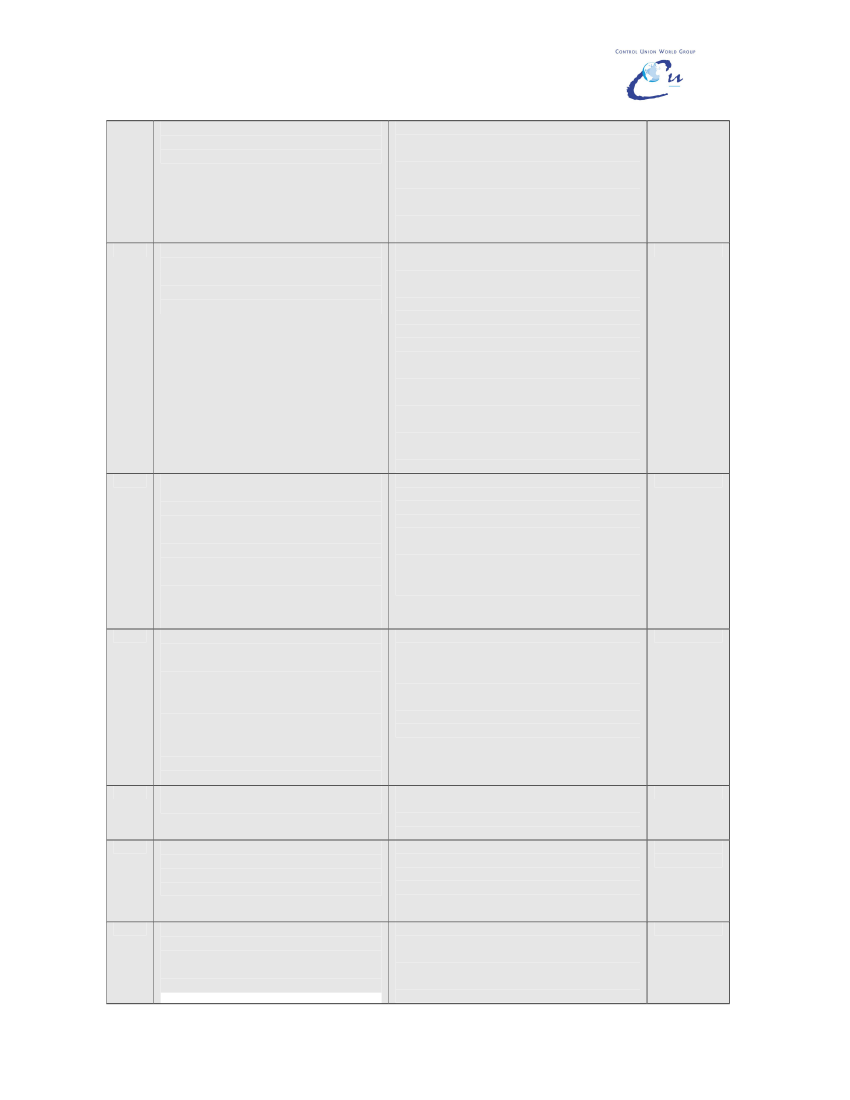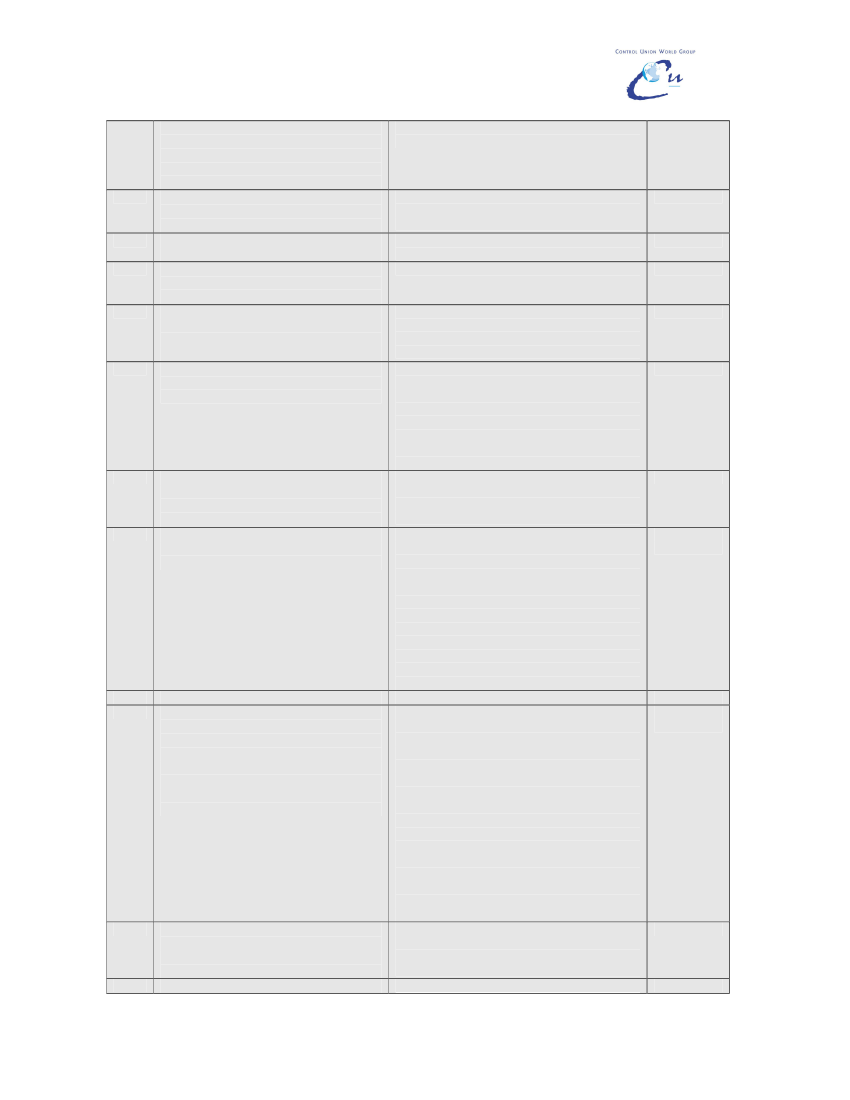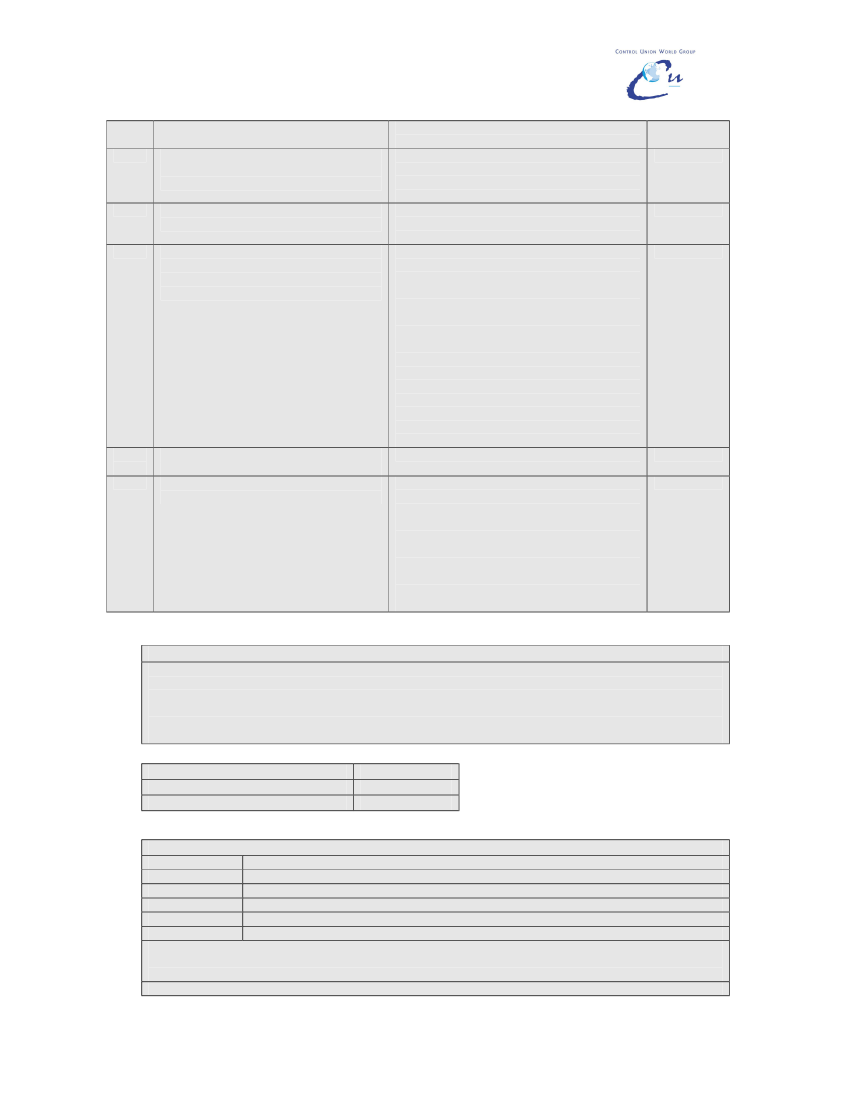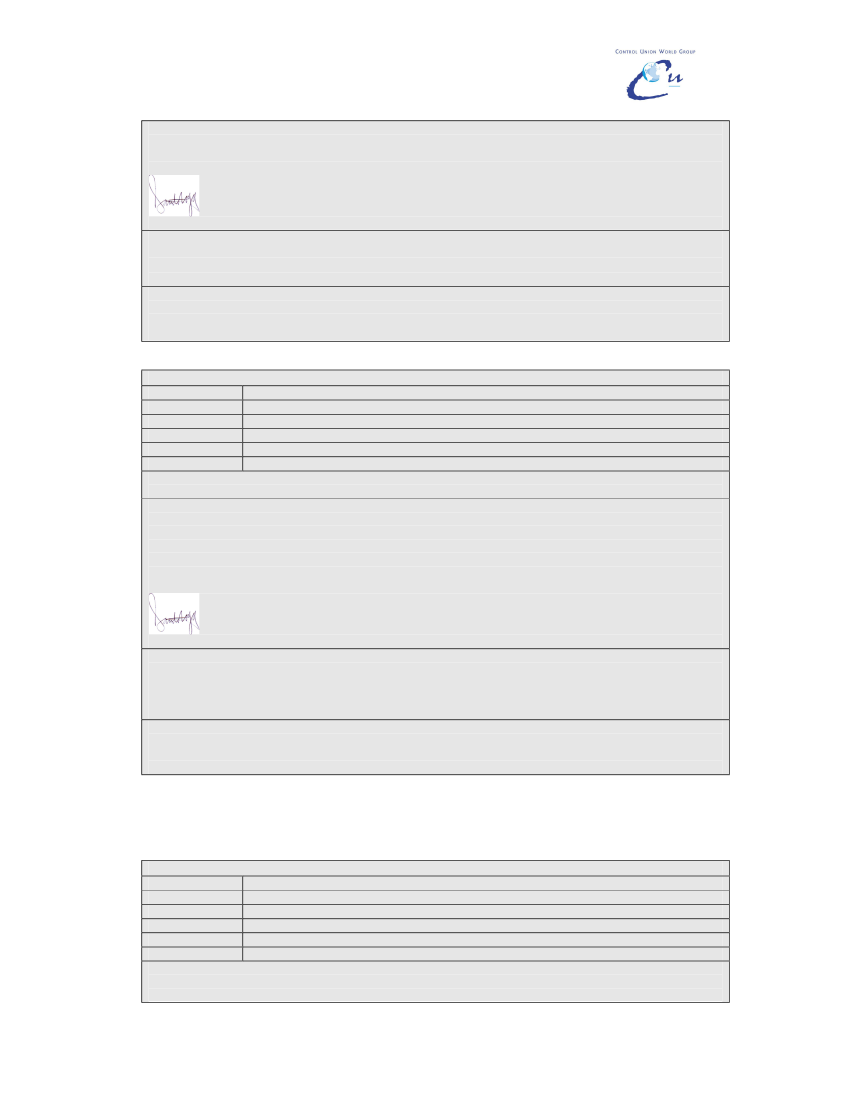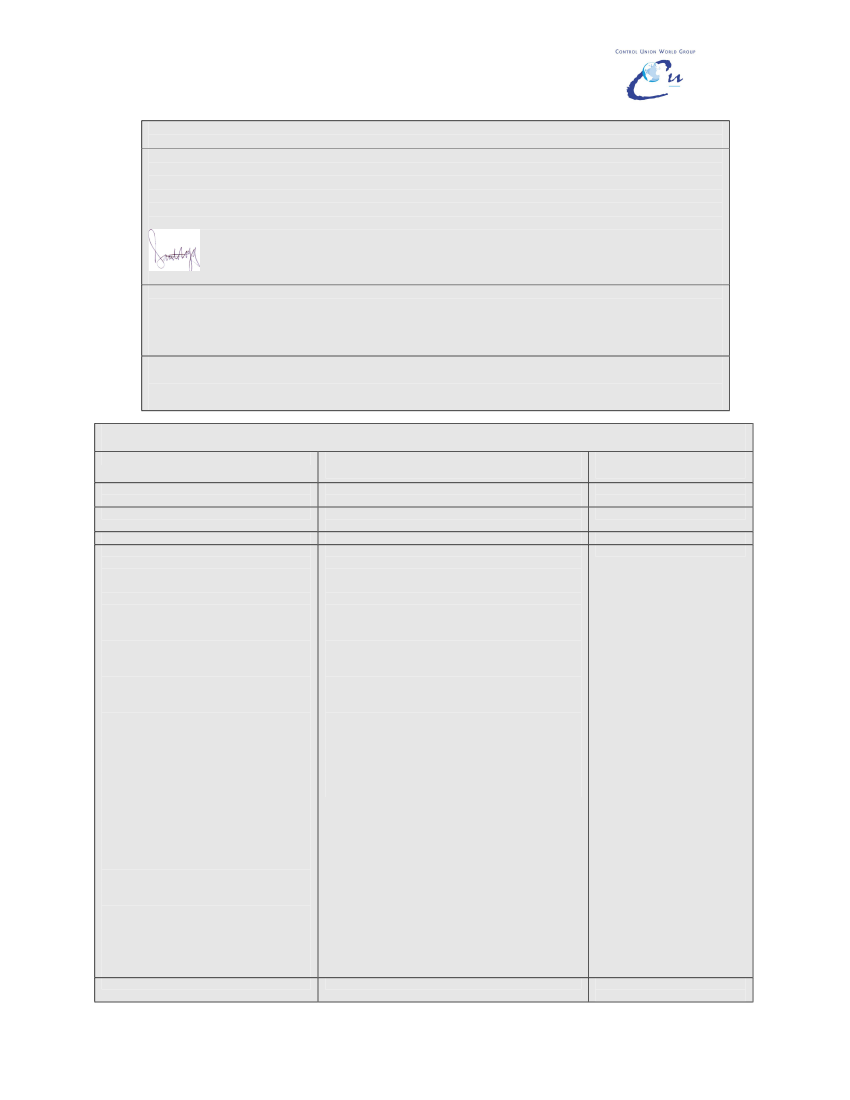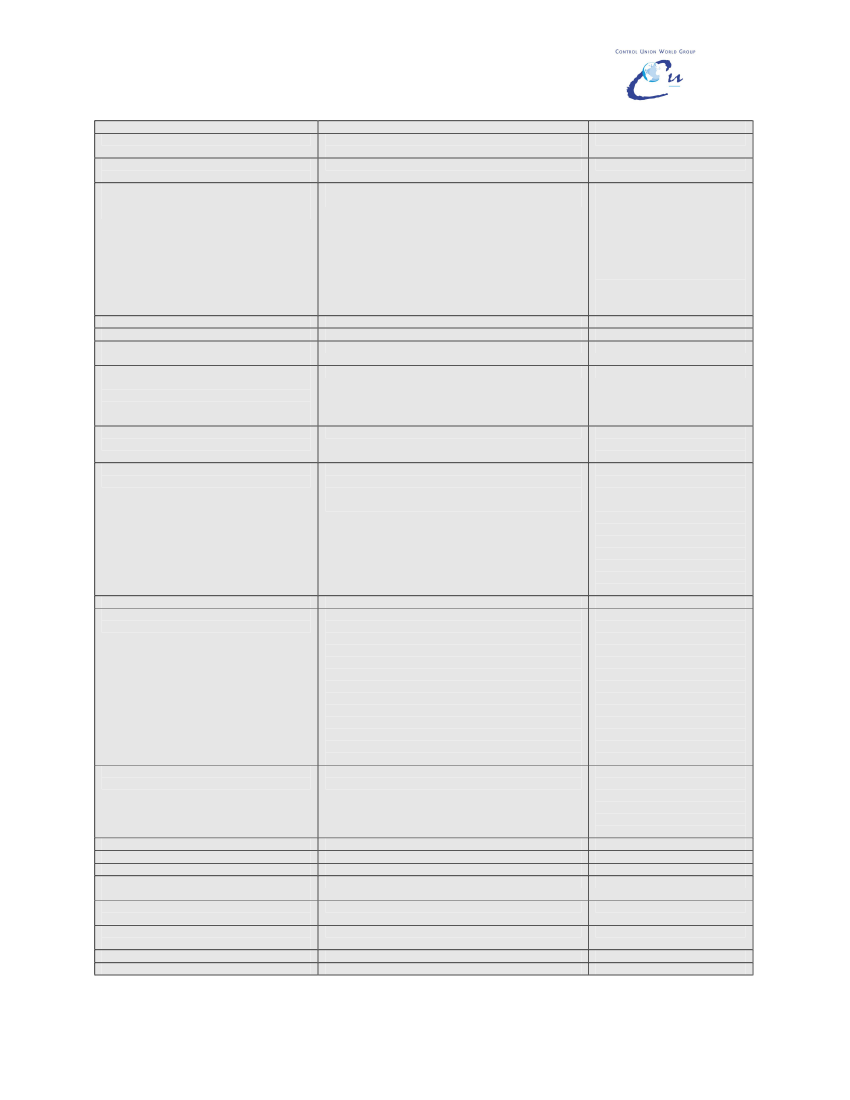Miljø- og Planlægningsudvalget 2010-11 (1. samling)
MPU Alm.del Bilag 96
Offentligt
RSPO Assessment ReportPUBLIC SUMMARY
UNITED PLANTATIONS BHD.PENINSULAR MALAYSIAThis public summary has been prepared in accordance with RSPOrequirements and the information included is the result of a full RSPOassessment of the Mills and supply base as included in the scope of thecertificate.
Report prepared by: David Ogg FICFor. (Lead assessor).Certification decision made by: Gerben Stegeman.
Control Union (Indonesia)Jl Kramat 3A,Cilandak TimurJakarta Selatan 12560Phone: 062-21-7884 2016[email protected]
Control Union (Malaysia)Persiaran Raja Muda Musa,Off Jalan Sg.Berith, Teluk Gadong, 41100,Klang, Selangor.Phone 03-3377 1600 / 1700[email protected].
Control Union Certifications. (Head office)Meeuwenlaan 4-6,P.O. Box 161.8000 AD Zwolle.The Netherlands.[email protected]
Phone: 0031 38436 0100Control Union Certifications is a member of the Control Union World Group - an international inspection andcertification body. CU performs assessments and certification in many agricultural based fields such asFSC, RSPO, and Organic production, Sustainable Textile Production, Organic Exchange, Eurepgap,HACCP, BRC, GMP and GTP.CU is accredited by the Dutch Council of Accreditation (RVA) on the European quality standard EN 45011for the inspection and certification of CU Organic program (according to the EU regulation 2092/91) andEUREPGAP program. When requested a copy of the accreditation certificate can be obtained from CU.
Page 1 of 23
www.controlunion.comContents1. Scope of the Certification Assessment.1.11.21.3National Interpretation used for the assessment.Assessment type. (mill, estate and mill, plantation only etc. etc)Location maps.1.3.1Map to show geographical location.1.3.2Map to show the supply base and neighbouring entities.1.3.3Location addresses of the mill(s).1.3.4Approximate tonnages certified. (CPO and PK).Description of supply base.1.4.1General description.1.4.2Location of the supply base including:•Control Union code for the certificate.•Location address.•GPS reference.1.4.3Statistics of supply base including:•Control Union code for the certificate.•Area of oil palm.•Mature area.•Estimated annual FFB production in tonnes.•Planting years.•Cycle.Other certifications held (ISO etc)Organisational information/contact personTime bound plan for other management units and justificationsDate certificate issued and scope of certificate
1.4
1.51.61.71.8
2. Assessment Process2.12.2Certification body.Qualifications of the assessment team.2.2.1Qualifications of the lead assessor.2.2.2Qualifications of the assessment teamAssessment methodology.2.3.1General overview.2.3.2Assessment agenda including:•Assessment dates.•Sites visited.•Main activities.•Total number of person days spent on site.Stakeholder consultation.2.4.1Summary of how stakeholder consultation was organised.2.4.2List of National and International stakeholders consulted.Date of next surveillance visit.
2.3
2.4
2.5
3
Assessment Findings3.13.23.33.43.5Lead assessor’s summary and recommendation for certification.Summary of the findings by criteria.Non conformity register.Issues raised during stakeholder consultation and company responses.Formal sign-off of the assessment findings.3.5.1Acknowledgment of internal responsibility by the client.
Page 2 of 23
1.
SCOPE OF THE CERTIFICATION ASSESSMENT.1.1 National Interpretation used.
The management of the Palm Oil Mill(s) and associated suppliers of FFB were assessed forcompliance against the 2008 International RSPO criteria as interpreted and endorsed forMalaysia.
1.2 Assessment type. (Mill, Estate and Mill, Plantation only etc. etc).6 Palm Oil Mills and 3 business units with a total of 9 estates owned by the company.
1.3 Location maps.1.3.1 Maps showing the location of the United Plantations in the States of Perak and Selangor.
Page 3 of 23
Map to show the location of estates, factories and holdings in Peninsular Malaysia.
Page 4 of 23
1.3.2 Map to show the supply base and neighbouring entities. (Jendarata).
1.3.3 Location of mills.Name of MillJendarata Palm Oil Mill.Seri Pelangi Palm Oil Mill.Ulu Basir Palm Oil MillLima Belas Palm Oil MillUlu Bernham Palm Oil Mill.United International EnterprisesPalm Oil Mill
LocationJendarata Business Unit, 36009 Teluk Intan, Perak, MalaysiaJendarata Business Unit, P.O Box 89 11 � Miles, Jalan Bidor, 36008Teluk Intan, Perak, MalaysiaUp River Business Unit, 36500 Ulu Bernam, Perak, Malaysia.Up River Business Unit, 35800 Slim River, Perak, Malaysia.UP River Business Unit, 36500 Ulu Bernam. Perak, Malaysia.United International Entreprise (Malaysia), Mail Bag No 1, 34900,Pantai Remis, Perak, Malaysia.
1.3.4
Approximate tonnages certified.CPO35,1419,37635,93310,53036,13658,205PK8,2112,1309,6952,64110,51317,005
Name of MillJendarata Palm Oil Mill.Seri Pelangi Palm Oil Mill.Ulu Basir Palm Oil MillLima Belas Palm Oil MillUlu Bernam Palm Oil Mill.UIE (M) Palm Oil Mill
1.4 Description of supply base.1.4.1 General description.The supply base are the 9 plantations that make up the 3 business units of the UnitedPlantations holdings located in Peninsular Malaysia. There are no plans to expand the landholding and therefore Principle 7 is not applicable to this assessment.
Page 5 of 23
1.4.2 Location of the supply base.CU CodePO1PO2PO3PO4PO5PO6PO7PO8PO9EstateName of estate:Jendarata Business UnitJendarata EstateSeri Pelangi EstateUP River Business Unit.Ladang Ulu BasirChangat Mentri EstateLadang Sungei ErongLadang Sungei ChawangLima Belas EstateUlu Bernam EstateUIEM Business UnitUIEM Sdn, Bhd. Estate 1sndEstate 2Location.Teluk Intan, Perak3�52’ N. 101�.01E.3�59 N. 101�.08 E.
GPS reference.
Perak.3�42’3�44’3�46’3�50’3�42’3�45’N.N.N.N.N.N.101�.15101�.13101�.12101�.14101�.27101�.07E.E.E.E.E.E.
Selangor.Pantei Remis, Perak
4�25’ N. 100�.40 E.
1.4.3 Statistics of the supply base.CU CodePO1PO2PO3PO4PO5PO6PO7PO8PO9Name ofestate.JendarataEstateSeri PelangiEstateLadang UluBasirChangat MentriEstateLadang SungeiErongLadang SungeiChawangLima BelasEstateUlu BernamEstateUIEM Estate1&2
Area of oil palm (ha)Oil PalmMature594113343778242034843500275731549335
EstTonnesFFB/yr160000350009970063500854009240072008350025600
PlantingyearsAll estates.Vary between1975 to 2008.
Cycle(years)Cycles:Between25 and 30years.
42309352644168722732450191422146803
1.5 Details of other certifications or awards held.Joint winner for the Malaysian Business Corporate Social Responsibility (CSR) Award. (EnvironmentalPerformance).Anugerah Hibiscus Perdana Menteri. Prime Minister’s Hibiscus Award for 2006/2007.Anugerah Cemerlang Keselamantan Dan Pekerjaan Kebangsaan 2004.Anugerah Cemerlang Keselamantan Dan Kesihatan Pekerjaan Kebangsaan 2006.
1.6 Contact person.Principle Contact person:Business address:Group name if applicable:Office telephone:Mobile telephone:Fax:e-mail:Web site:Mr C MathewsJendarata Estate, 36009 Teluk Intan, Perak Darul Ridzuan,Malaysian/a+605 6411 411+601 9339 2298+605 641 2337[email protected]www.unitedplantations.com
Page 6 of 23
1.7 Time bound plan for other management units and justifications.The time frame laid out below is considered to be both challenging and realistic. The company will be usingthe experience of the main assessment to ensure that the other management units conform to the RSPOprinciples and criteria.The audit team are satisfied that United Plantations conform with the RSPO requirements for partialcertification as laid out in the Final RSPO Certification Systems document, May 2007, section 4.2.4Progress will be verified and reported in subsequent surveillance visits.
Name of plantation.Pt Surya Sawit SejatiPt Sawit Seberang Seberang
GeneralLocationCentralKalimantan
Area Summary (ha)TotalPlanted15,65018,000Underdevelopment.
Time boundtimetable.20132016
1.8 Date certificate issued and scope of certificateName of Client:Client number:Certificate number:Certification Decision Date:Issued byAddressTelephoneFaxEmailWebsiteScopeName of Mill:Scope (Summary of suppliersof FFB):Projected mass balance CPO:Certificate registration code:Type of certification:Name of Mill:Scope (Summary of suppliersof FFB):Projected mass balance CPO:Certificate registration code:Type of certification:Name of Mill:Scope (Summary of suppliersof FFB):United Plantations Bhd.CU809027CUC809027August 21, 2008Control Union CertificationsGroup scheme: YesMeeuwenlaan 4-68025 BS Zwolle0031 (0) 38 426 01000031 (0) 38 423 7040[email protected]www.controlunion.com/certification
Jendarata Palm Oil Mill.•PO1 – Jendarata Estate.35,141.27 tonnesCU809027D01Single site: YesSeri Pelangi Oil Mill.•PO2 –Seri Pelangi Estate.9,376.65 tonnesCU809027D02Single site: Yes
Group scheme: Yes
Group scheme: Yes
Projected mass balance CPO:Certificate registration code:Type of certification:Name of Mill:Scope (Summary of suppliersof FFB):Projected mass balance CPO:Certificate registration code:
Ulu Basir Palm Oil Mill•PO3 – Ladang Ulu Basir.•PO4 – Changat Mentri Estate.PO5 – Ladang Sungei Erong.••PO6 – Ladang Sungei Chawang.35,933.27 tonnesCU809027D03Single site: YesGroup scheme: YesLima Belas Palm Oil Mill•PO7 – Lima Belas Estate10,530.13 tonnesCU809027D04
Page 7 of 23
Type of certification:Name of Mill:Scope (Summary of suppliersof FFB):Projected mass balance CPO:Certificate registration code:Type of certification:Name of Mill:Scope (Summary of suppliersof FFB):Projected mass balance CPO:Certificate registration code:Type of certification:
Single site: Yes
Group scheme: Yes
Ulu Bernam Palm Oil Mill.•PO5 – Ladang Sungie Erong.•PO6 – Ladang Sungei Chawang.PO8 – Ulu bernam Estate.•36,136.80 tonnesCU809027D05Single site: YesGroup scheme: YesUnited International Enterprises (Malaysia) Palm Oil MillPO9 – UIE (M) Sdn. Bhd. Estate 1 and Estate 2•58,205.68 tonnesCU809027D06Single site: Yes
Group scheme: Yes
Certifier (contact person)Signature
Gerben Stegeman.
Page 8 of 23
2.
ASSESSMENT PROCESS.2.1 Certification Body.
Control Union Certifications is a member of the Control Union World Group - an international inspection andcertification body. CU performs assessments and certification in many agricultural based fields such asFSC, RSPO, and Organic production, Sustainable Textile Production, Organic Exchange, Eurepgap,HACCP, BRC, GMP and GTP.CU is accredited by the Dutch Council of Accreditation (RVA) on the European quality standard EN 45011for the inspection and certification of CU Organic program (according to the EU regulation 2092/91) andEUREPGAP program. When requested a copy of the accreditation certificate can be obtained from CU.
2.2 Qualifications of the assessment team.2.2.1 Qualifications of the lead assessor. David Ogg FICFor.REQUIREMENTA minimum of post high school (postsecondary school) training in eitheragriculture/forestry, environmentalscience or social sciences;At least 5 years professionalexperience in area of work relevant tothe assessment (e.g., palm oilmanagement; agriculture/forestry;ecology; social science);Training in the practical application ofthe RSPO criteria, and RSPOcertification systems;Successfully completion of an ISO9000:19011 lead assessors course;A supervised period of training inpractical assessmenting against theRSPO criteria or similar sustainabilitystandards, with a minimum of 15 daysassessment experience and at least 3assessments at differentorganisations.QUALIFICATIONSOND (credit) Forestry. Newton Rigg College ofAgriculture and Forestry. Penrith, Cumbria. U.K.1978 to 1981Professional forester since 1981.1987. Passed the examinations necessary to beaccepted as a member of the Institute of CharteredForesters.2004 Promotion to a Fellow of the ICF.Instrumental in the preparation of the CUCcertification systems. Fully trained in similarcertification programmes such as FSC, PEFC,GOTS, Organic Exchenge.BATALAS ISO 900:2000 lead assessors course.September 2007.Extensive experience in the Palm Oil industry byconducting pilot projects with 4 different companiesthroughout Malaysia and Indonesia from August2006 to August 2007. Developed the CUCassessment checklist and system plans andtraining new assessors as team members.Conducted a significant number of assessmentssince 1998. (In excess of 3,000).SmartWood. Soil Association.Indfor:700 group members including PEFC andFSC FM and COC;Control Union:GOTS, GGL, FSC COC,CRAMER, OE, Recycle standard.RSPO to date:4 x pre-assessments.5 x main assessments. (Malaysia, Indonesia andColombia).ComplianceYes
Yes
Yes
Yes.Yes.
Page 9 of 23
2.2.2 Qualifications of assessment team.RSPO REQUIREMENTASSESSORFluent in main local languages Mr Manivannanand English.Dr RamadasanField working experience in the David Oggpalm oil sector, or ademonstrable equivalent.Mr Manivannan
Good agricultural practices(GAP), integrated pestmanagement (IPM), pesticideand fertilizer use.
David Ogg
Mr Manivannan
Van DongHealth and Safetyassessmenting on the farmand in processing facilities.(For example OHSAS 18001or occupational. Health andsafety assurance system).David OggMr Manivannan
Van DongWorkers welfare issues andsocial assessmentingexperience. (For example withSA8000 or related social orethical accountability codes).David OggMr Manivannan
QUALIFICATIONSMalaysian citizen.Malaysian citizen.Professional forester since1981.See also above.2 years of plantationmanagement.7 years with corporateagriculture financing. Degree inagribusiness.Professional forester since1981.See also above.Global Gap and GMPB2. 7years assessment experience.Standards include GAP andIPM.Agricola Buen Ano – Mexico.Technical advisor.Global Gap auditor.Professional forester since1981.See also above.Global Gap and GMPB2. 7years assessment experience.Standards include GAP andIPM.Global Gap auditor.Professional forester since1981.See also above.Global Gap and GMPB2. 7years assessment experience.Standards include GAP andIPM.Global Gap auditor.Social. (Tuesday 27 only).Biodiversity and environmentalforest management.Global Gap standard.WWF and environmentalstudies.Managing Director of forestmanagement company for 18years.7 years with corporateagriculture financing. Degree inagribusiness.th
ComplianceYesYesYes
Yes
Yes
Yes
YesYesYes
YesYesYes
Van DongVijayaEnvironmental and ecologicalassessmenting. (For exampleexperience with organicagriculture, ISO 14001 orenvironmental managementsystems).Economic issues.David OggMr ManivannanDr Ramadasan
YesYesYesYesYes
David Ogg
Yes
Mr Manivannan
Yes
Page 10 of 23
2.3
Assessment methodology.
2.3.1 General overview.The assessment was carried out in conformity with the procedures as laid down in the CUC RSPOProcedure Manual and the program manual for the assessor and certifier. During the assessment thequalified CUC assessors used the RSPO standard as endorsed for the country in which the assessmenttook place and recorded their findings.Due to the location and proximity of the estates, combined with the common management systems andinformation derived during the pre-assessment, it was possible to carry out both field and officeassessments of all 9 estates within the time frame without compromising the integrity of the assessments inanyway.All 9 estates and the 6 mills were visited and the assessment team carried out field and office assessmentsof compliance for all the RSPO principles and criteria. Common systems were identified and specificevidence was recorded for individual estates. Interviews with managers took place in both formal andinformal environments and worker interviews were conducted on all estates and in both mills.The lead assessor designated particular assessment tasks to individual team members or to teams of 2,depending on their area of expertise or skills to ensure full coverage of the principles and criteria.
2.3.2 Assessment agenda.Date26thMayLocation /mainsitesBOP Club.••••26th MayMorning andAfternoonUlu Basir Oil Mill.Ulu Basir estateChangkat Mentri –Grut Forest Reseve.Group hospital.Ulu Bernham nursery.Wetlands creek.Ulu Berhnm Oil Mill.
••
•••••••••••••
Evening.Kampong Orang Asli
•
Main activities(Detailed for 26thand summarised thereafter).Opening meeting. Introduction by team leader. Introductionof team members and assessment agenda.Over view by GM-HR & ESH.Presentation of estates RSPO pictorial summary by respectivemanagers.Presentation of Oil Mills source of FFB by respectivemanagers.Chemical stores.Storage. MSDS leaflets. Herbicide mixingareas. PPE. Ventilation. Security.Field inspections.Herbicide application programmes.Harvesting sites and efficiency. Fertilising operations. SOP’s.Soil maps. Land preparation. Ground cover. IPM. First aidersand boxes. Ground cover. Soil erosion. Field observations of alloperations.Worker interviews.OSH. Sexual, religious, racial harassment.Pay and contracts. Child labour. First aid. Awareness.Re-planting sites.Zero burn.HCV’s.Identification. Management plans. EnvironmentalImpact Assessments. Implementation.Riparian zones.Width. Current and future management. Nonmaintenance regimes.Water management.Water courses. Water monitoring.Road maintenance.Run off.Social amenities.Hospital. Old Folks Home. Bakery. Schools.Creche. Social Impact Assessments.Local communities.Contributions made. Employmentopportunities. Social impacts. Complaints procedures.Work shops.Oil traps. Safe working environment. PPE. Dieseltanks. Environmental waste management.Line sites.Interviews with householders. Inspection of waterdischarge points. Water improvement plans. Waste disposal.Document inspection and assessment.Mill and workshop inspections.Documentation. Workerinterviews.Mills.SOP’s. Safe working environment. Gen sets. Walk ways.Signs. EFB. POME treatment. Emissions. Mass balance. Dieseltanks. PPE. Fire extinguishers. First aiders and boxes. Fuel andwater usage.OSH.Training. Management structure. First aiders.
Page 11 of 23
27thMay27thMayAfternoon.
28 May
th
Follow up visits asa result of thestakeholdermeeting.Lima Blas Oil Mill.Lima Blas estate.Sg. Erong / Sg.Chawang Estate.Document review.
•Full document review.Completion of the checklist. Reviewand documentation of evidence. All aspects of RSPO P&C’s.•Worker interviews.OSH. Sexual, religious, racial harassment. Pay and contracts.•Document inspection and assessment.•Open stake holder meeting.•Ferry crossing.•Schools.•Tree management.•Road management.th•Otherwise as for 26 May,••••••••••••••••••••••••••Social amenities.Zero burn replant.Water management.Field operationsAudit of all estates documentation at central location withspecific files from individual estates to close out any gaps in theassessment.Mill inspection.Workshops.Stores.POME application.Document review.
29thMay
UIEM Oil MillUIEM estate3Seri Pelangi Oil MillSeri Pelagi Estate..
30thMay
Jendarata Oil Mill andEstate.
30thMayAfternoon
BOP Club
Social amenities.Tan Sri Bek-Nielsen Wildlife Sancturay.EFB application.Water management.IPMForest Tree – plantings for seedlings.Field operations.Review of UIEM Business unit documentations.BRB Boiler.Biogas plant.POME. Land application.Zero burn replant.LCC and IPM.Light railway system.Water management.Social amenities.•Closing meeting. Chaired by the assessment team leader.Welcome and introduction by the team leader.Presentation of findings by the assessment team.Questions and answers.•Final summary by team leader.
Number of assessors participating: 5Number of days spent for the assessment on site: 5Total number of person days used for the assessment on site: 21 (One assessor for one day only)
Page 12 of 23
2.4 Stakeholder consultation2.4.1 Summary of how the stakeholder consultation was organised.United Plantations included a list of 180 local stakeholders in their application form to CUC. (A number ofstakeholders requested anonymity).All 180 stakeholders and an additional 13 National and International stakeholders as identified by UP andCUC were invited to make written responses to a questionnaire. The questionnaire includes full details ofthe company to be assessed, the names and addresses of all the mills and supply base, the dates of theassessment and the date time and place of an open stakeholder meeting.Notification was also posted on the CUC and RSPO web sites.12 questions are asked. In summary:1. Do you have any remarks on the RSPO standard?2. What is your relation with the applicant.3. Are there any plantation or mill management practices that affect you?4. Do you consider any management is in conflict with the RSPO principles and criteria?5. Do you have any suggestions for management?6. Are you aware of any HCV in the plantations or in adjacent land?7. Are you aware of any endangered or rare species?8. Are there any adverse (or positive) effects on local communities?9. Additional comments.10. Are you likely to attend the open stakeholder meeting?11. Do you have any comments about the assessment team and would you like to meet with them?12. Do you have any comments of the applicants management of any other plantations?112 responses were received which included issues to be investigated during the assessment.The open stakeholder meeting was attended by 150 people and the issues raised in the questionnaireswere once again raised and discussed.Subsequently the assessment team discussed those issues with UP management team (See 3.3 below)and made site visits.The vast majority of the responses were positive regarding the work and social ethics of the company.2.4.2 List of the National and International stakeholders contacted.EPFSocsoNUPW. 4 offices.AidEnvironment.Forest PeoplesPACOSMICPolisLabour DepartmentEmyza bt SudinSawit WatchWWFSabah Forestry.RSPO and CUC web sites.
2.5 Date of next surveillance visit:
August 2009
Page 13 of 23
3.
ASSESSMENT FINDINGS.
3.1 Lead assessor’s summary and recommendation for certification:A pre-assessment audit was conducted by David Ogg and Mr Manivannan from March 31sttoApril 4th2008 of the Jendarata Business Unit.During this audit the company’s management documents, management systems and SOP’s, asapplicable to all management units and plantations, were audited against the Malaysianinterpretation of the RSPO principles and criteria as available from the RSPO web site at thattime.The implementation of management systems were audited by conducting field, mill and bio-plant inspections; laboratory and nursery visit; worker and staff interviews; inspections ofworkshops and stores; visits to conservation areas and riparian zone management andinspection of all social amenities including the hospital, shops, bakery, sports facilities, watertreatment plant, crèche, graveyards, old folks home, places of worship and housing for bothstaff and workers.On the 2nd April a stakeholders meeting was held at 0800 attended by 36 persons. This wasfollowed by an inspection of the kindergarten and two schools as issues had been raised by theheadmistresses both before and during the stake holders meeting. (See below for full report).The audit schedule (see 3.2 above) was prepared by the lead auditor in full consultation with MrMathews. It was designed to ensure that all mills and estates included in the scope of thecertificates (if awarded) were included in the audit.Much emphasis has been given to developing their commitment to sustainable palm oil.After the 3rd Roundtable meeting in Singapore, where the test principles and criteria wereagreed upon, United Plantations arranged for a compliance audit of the RSPO principles andcriteria by ProForest which was conducted in January 2006. Since then they have continued todevelop their management systems in accordance with the national interpretation for Malaysia.The main audit was conducted by assessing compliance against the endorsed NationalInterpretation for Malaysia.There is a clear commitment to RSPO by top management and by the staff and workers in thefield. This was evident through interviews and through field, plant and laboratory inspections.United Plantations have prepared individual files for each and every principle and criteria andwhilst there is repeated information, this enables anyone to inspect the procedures, policies andrecords of all operations by going straight to the relevant file. This method is repeated in eachand every mill and estate office. Implementation of work is recorded by way of 29 checklistsand the files which include minutes of meetings, committees, stakeholders, SOP’s,environmental management, social issues, IPM techniques, records and reports covering alloperations and the full range of RSPO principles and criteria.This approach ensures that the company has fully considered all aspects of the RSPO P&C’s andduring the pre-assessment a detailed study of all the files was carried out at Jendarata businessunit. During the main assessment it was confirmed that the information audited at Jendarata isincluded in all the estate and mill files. A complete audit was conducted at the Up River BusinessUnit were files form all the estates of the business unit were available for inspection. A samplingwas carried out from all estates and mills to ensure that all Principles and Criteria were fullycovered.Site inspections of all business units included field operations and worker interviews; millinspections and worker interviews; workshop, chemical stores and worker interviews; housing;hospital; clinics and all other social amenities as for the pre-assessment. The audit team alsointerviewed shop keepers, the ferry crew and householders.
Page 14 of 23
The open stakeholder meeting was attended by 150 persons. Control Union received over 112replies to the pre-assessment stakeholder letter. Please refer to section 6 below for a full report,analysis and follow up action.Field operations inspected included:•Zero burn replant sites.•Mulching.•Ground cover.•Riparian zone management.•Harvesting.•Oxen extraction.•Herbicide application and interview of workers.•Railway haulage system.•Chemical stores.•Chemical mixing stations.•Fertiliser stores.Domestic waste disposal.High Conservation Value areas and other conservation initiatives were inspected and thecompany is highly commended for their recognition of the importance of creating new bio-diversity areas as well as the enhancement of existing features such as riparian zones andforest habitats.The team was particularly impressed with the establishment of the “Lagoon Nature Reserve” atUIE business unit. Incorporating a lagoon which is populated with a variety of fish and otters,Geoffrey Cooper (Sr Manager) has consulted with James Kingham and commenced a plantingproject of rare and endangered Malaysian species. To date 18 diverse tree families, 50 differentspecies and over 2,000 trees have been planted with the intention of not only creating a naturalforest system but to also provide a seed bank for future prorogation of these rare species.Social amenities and the relationship with local communities were given high priority during theaudit and during the stakeholder open meetings. The audit team were impressed with thefacilities and the support of management to the wider community. Water supply to some workerhouses and facilities was raised during the stakeholder consultations and interviews and themanagement are already taking steps to improve where necessary.During inspections of workshops, it was noted that some electrical connections and cables werein a poor / dangerous condition. Guards were missing on some pulley systems and diesel tankbunding was not always adequate (See non-conformities). A safe working environment does notfeature in RSPO criteria but it is the recommendation of the audit team that all electricalconnections and guards be inspected and a system for check and repair be implemented. (It isalso recommended that a criteria is added to ensure a “safe working environment in mills,workshops, stores and offices).United Plantations have adopted a “cradle to grave” approach in two important respects.•Research and continuing improvement of the seed, maximising the yield by soundagricultural practices, ensuring very high recovery rates of CPO in the mill and almost100% utilisation of all by-products such as kernel shell, fibre and bio gas.•Taking care of the pregnant workers and their children. Providing housing and wideranging social benefits such as schools, places of worship and a hospital. Providing anold folks home and finally the setting aside of land for graveyards.It is therefore the recommendation of the lead assessor that:•A certificate of compliance is awarded.Signed:
Name: David Ogg FICFor.Date: 30thMay 2008.
Page 15 of 23
3.2 Summary of the findings by criteria:1.11.2Findings:•Records of all requests for information.•Public documents available asrequired.•Clear compliance with the law.•Good systems in place to track andimplement changes.•Land titles / country leases for allproperties.•Mechanism for resolution of conflicts.•Boundaries identified.•No disputes noted.•No customary rights.•Annual budgets.•Annual replanting programmesprojected to 2013.•Up to date SOP’s covering alloperations.•Implementation of SOP’s.Comments:Comprehensive system with evidence ofaction taken as the result of a request forinformation.No restriction as to the documents that arepublicly available with the exception ofconfidential commercial information.All offices have a list of the relevant laws anddocument checks on licences and permits,statutory returns and other laws confirmedimplementation,Land titles inspected for all estates and themills. Boundary stones and markers seen andphotographed.ComplianceYes
Yes
2.1
Yes
2.2
Yes
2.33.1
Not applicable.Good financial planning with a 2 year rollingprojection.A total of nine key operations with a number ofsub operations make up the SOP. Covers allbest practices. Updates are circulated andthen included in the file and implemented.management.Mills: SOP’s for all both mills are the same.From FFB reception on weighbridge to CPOdespatch.Annual recommendations for fertiliser and EFBapplications.The field recommendations are made once ayear and are based upon solid type, agegroup, history. Annual leaf sampling of eachfield for nutrient analysis. There is a base linefor optimal minimum of all nutrients. Yieldlevels and to some extent the rain fall and pestand diseases are taken into account. All ofthese parameters are taken into account inpreparing the analysis. The total fertiliser useis almost $3million and so accuracy isimperative to ensure maximum yield withminimum cost of fertiliser input.POME applied for land irrigation.Clear evidence of zero burn policy beingimplemented.Soil maps. No fragile soils and very little steepground. Erosion management through reducedherbicide use and frond stacking.Low ground pressure tyres by way of twintyres, leguminous cover crop (Mucunabracteata) and mowing harvesting paths. Thisavoids blanket weeding. Maps show where theabove actions have taken place withphotographs.The earth worm activity is also monitored as asign of soil fertility.Road maintenance includes some roads aretarmaced.Water use averages 1.7 tonnes per tonne FFBwith a downward trend.
YesYes
4.1
Yes
4.2
•Well planned and managed fertiliserregimes.•Good monitoring of fertiliser inputs.•EFB and POME land application.•Zero burn policy
Yes
4.3
•••••••
Soil maps.No fragile soils.Good ground cover.Frond placement to reduce erosion.Terracing.Road maintenance programmes.No peat.
Yes
4.4
•Good levels of water usage per tonneof FFB processed.
Yes
Page 16 of 23
•No drainage into protected areas.•Water management plans.
4.5
•Documented and implemented IPMsystem.•Monitoring of IPM used.•Planting of beneficial plants.•Monitoring of pesticide use per ha.
4.6
4.7
4.8:
•Written justification for allagrochemicals used.•All pesticides are officially registered.•Well ventilated and secure chemicalstores with MSDS leaflets and first aid.•Annual medical checkups.•No work for breast feeding or pregnantwoman.•Paraquat is being replaced.•Chemical residue testing of CPO.•Records of pesticide use.•OSH plans in place and implementedand good records.•OSH committees and responsiblepersons.•Documented risk assessments.•Accident and emergency procedures.•First aiders at all sites.•First aid kits at all places of work.•Training programmes.•Accident records.•Worker insurance in place.•Training plans and records asappropriate for all staff and workers.•Documented and implemented impactassessments.•Environmental improvement plans inplace and positive action implemented.•HCV assessments completed.•Management plans are well preparedand are being implemented.•HCV’s are generally the riparian zones.•HCV waterfall jungle reserve is well
Water supplies to all linesites are beingimproved.Prawn breeding is carried out by onestakeholder who takes water from the river. Heinforms the estate and when he is taking waterand the estate closes the discharge gates nearhis farm. In reverse the estate tells the fishfarmer when discharge is taking place and thisis recorded.Integrated pest management and pest anddisease control. The concept is to harmonisenatural control with where there is a need tointervene with chemical control. The use ofpheromones. Beneficial plants. Barn owls.Chipping and pulverizing of felled palm trees.Use of biological control. Chemical control.Manual control. Census. Identification.Treatment. Evaluation and record keeping.Throughout all estates the use of beneficialplants such as Tunera subulata, Cassiacobanensis, Mucuna bracteata, Antigononspp. are very evident. Replant sites arerestructured to allow enough light for theseplants. Leguminous cover crops are also well-established to suppress growth of noxiousweeds.The chemical stores a re well planned andmanaged with good ventilation. Pre-mixingtakes place in bunded areas with showerfacilities. Inspection of records, interviews withthe workers and medical staff confirmed thatannual check ups take place and pregnant andbreast feeding woman are assigned otherwork.
Yes
Yes
The OSH plans and documents are wellthought out and is also displayed in the workplaces. Interviews with workers confirmedknowledge of the plans and procedures andfirst aid training records were inspected andalso confirmed by interview. Safe workingenvironments observed in mills and places ofwork.
Yes
5.1
5.2
Annual training programme for all workers.Regular assessments take place to ensure allworkers are up to date with training. Trainingrecords inspected.Plans to mitigate negative impacts are in placefor all estate and mill operations / activities.5.1.2: A number of diesel tanks inspected hadinadequate drainage systems and / or pumpsand pipes outside the bund. The result of thisis ineffective containment of leakage.Riparian zones are identified on maps andmarked on the ground using coloured poles.Non maintenance regimes and jungle treeplanting is taking place.A number of diesel tanks inspected hadinadequate drainage systems and / or pumps
Yes
No (see NC01/2008)
Yes
Page 17 of 23
•
5.3
5.45.5
••••••••••
5.6
6.1
protected.Illegal activities are activelydiscouraged and signs around theestate make it clear that hunting,fishing etc is illegal.Waste products identified.Plans to avoid pollution are in place.EFB and POME are used for fertiliser.All energy used in the mills ismonitored.No evidence of burning anywhere onany estate.Previous crops chipped and shredded.Plans in place to mitigate all pollutingactivities.Pollutants are identified.No peat.Documented and implemented socialimpact assessments prepared inparticipation with affected parties.
and pipes outside the bund. The result of thisis ineffective containment of leakage.
Scheduled waste is stored in appropriatefacilities and disposed off by licensedcompanies. Land irrigation inspected.Monitoring records inspected and found to bein accordance with industry standards.SOP’s and evidence on ground.
Yes
YesYes
Management of waste plans. Scheduled wasteidentified and stored appropriately.
Yes
6.2
6.3
•Clear and transparent communicationwith local stakeholders.•Extensive lists of stakeholders.•Identified lines of communication.•Complaints and dispute resolutionprocedures which is used.•Procedure is fully available.
6.46.5
•No customary lands.•Contracts of pay and conditions incompliance with the law.•Housing, water supplies, medical,educational and welfare amenitiessupplied.•Improvement implemented to line sitewater supplies and to waste waterdischarge,
6.6
6.7
•Minutes of meetings with trade unionsand worker representatives.•Published statement recognizingfreedom of association. 6 languages.•No child labour.
All social impacts due from estate/milloperations have been identified throughextensive consultation with relevantstakeholders and mitigation measures havebeen determined. These have beenincorporated into the appropriate action plansto be executed by designated personnel withina specified timeframeThe stakeholder meeting and interviewsconfirmed that communications andrelationships between the estates andstakeholders is good.Documented and inspected. Confirmation byinterview that the system is accepted andworks in a timely manner.6.3.2: The system to resolve disputes isclearly in place and there are records of allmeetings. The "grievances and complaints"that have been raised have been resolved inan effective and timely manner as confirmedby interview. However, it is not clear if theissues raised at stakeholder meetings havebeen acted upon in an effective and timelymanner.Not applicable.Pay and conditions and contracts wereinspected in all offices and discussed duringworker interviews. They are understood by allworkers. Linesites were inspected and it isnoted that water supplies are being improved.Kindergarten, schools, a hospital, old folkshome, bakery and nursery crèches aremaintained by the estates.6.5.3: The housing provided and the standardvaries as there is an on going improvementprogramme. However, water supply wasraised as an issue by stakeholders and duringworker interviews. Supplies are not alwaysadequate. (Especially Up River BusinessUnit). See also stakeholder record in publicsummary.Minutes of meeting with worker reps arerecorded. Meeting with worker reps is throughthe various committees (eg: OSH Committee,and Sexual Harassment Committee).Interviews and inspection of records and
Yes
Yes
No (see NC02/2008)
YesNo (see NC03/2008)
Yes
Yes
Page 18 of 23
6.8
•Publicly available equal opportunitiespolicy.•No evidence of discrimination.•Well displayed and clear policy onsexual harassment.•FFB is supplied by the estates ownedby the company.•Suppliers of services paid in a timelymanner.
6.9
6.10
labour registration cards confirmed noemployment of children below the age of 16.Policy displayed in office and muster grounds.Wage records inspected and rates confirmedas being the same for male and femaleworkers and migrant workers.Policy publicly displayed in office and atlinesite. Worker interviews confirmed that nosexual harassment takes place.Interviews with suppliers of services confirmedthat they are fairly treated and paid promptly.UIEM Mill. The only mill that sources FFB from3 out side suppliers. The crop is inspectedevery year and an agreement is madebetween the two parties including quality,payment terms, delivery times, weight andforce majeur etc.When the crop is received the price is basedon the extraction rate. The price is adjustedevery month based on the price given by theMPOB. The file contains a clear calculation ofthe net payment having taken into account theextraction rates, haulage and processingcosts.
Yes
Yes
Yes
7.1 to7.78.1
•Not applicable as no new planting isplanned.•Clear evidence of continualimprovement in key areas.
YesParaquat is being reduced. SOPs' provide forreducing herbicide by inter mowing, small spotsprays around palms and careful calibration ofsprayers.POME, EFB etc is all fully utilised and thecompany is collecting Methane at Jendrarta.This practice is being extended to all millsprogressively. Waste products are recycled.On going house improvements. Regularstakeholder meetings.Yes
3.3 Non conformity register.This section gives an over view of new or revised non-conformities raised during this assessment and ofaction taken to close out non-conformities raised during the previous assessments.Major non-conformities raised during a main assessment will prevent CU from making a positive certificationdecision for the concerned units/products.The NC number is comprised of 2 parts to include the year in which the NC is raised as well as asequential number.
Date:Number settled (See 5.1):Number outstanding (See 5.2):
22
August-3
NON CONFORMITY REPORTNC number:01/2008Client name:United Plantations BerhadClient number:CU809027Date raised:30thMay 2008Major or Minor:MinorRaised by:David Ogg FICFor.Aspect of standard:5.1.2 Environmental improvement plan to mitigate the negative impacts and promote the positiveones, is developed, implemented and monitored.Evidence of non-conformity:
Page 19 of 23
A number of diesel tanks inspected had inadequate drainage systems and / or pumps and pipes outside thebund. The result of this is ineffective containment of leakage.Auditors signature:
Date: 30 May 2008.Proposed corrective action / improvement action.Inspect ALL diesel tanks and ensure that they comply with environmental standards.Timeline for conformance:Time of next annual surveillance.Review of corrective /improvement action:Auditors signature:Date:
th
NON CONFORMITY REPORTNC number:02/2008Client name:United Plantations BerhadClient number:CU809027Date raised:30thMay 2008Major or Minor:MinorRaised by:David Ogg FICFor.Aspect of standard:6.3.2 The system resolves disputes in an effective, timely and appropriate manner.Evidence of non-conformity:The system to resolve disputes is clearly in place and there are records of all meetings. The "grievances andcomplaints" that have been raised have been resolved in an effective and timely manner as confirmed byinterview. However, it is not clear if the issues raised at stakeholder meetings have been acted upon in aneffective and timely manner.Auditors signature:
Date: 30thMay 2008.Proposed corrective action / improvement action.Records need to be maintained of action taken.
Timeline for conformance:Time of next annual surveillance.Review of corrective /improvement action:Auditors signature:Date:
NON CONFORMITY REPORTNC number:03/2008Client name:United Plantations BerhadClient number:CU809027Date raised:30thMay 2008Major or Minor:MinorRaised by:David Ogg FICFor.Aspect of standard:6.5.3 Growers and millers provide adequate housing, water supplies, medical, educational andwelfare amenities in accordance with Workers’ Minimum Standard of Housing and Amenities Act
Page 20 of 23
1990 (Act 446) or above, where no such public facilities are available or accessible not applicable tosmallholders).Evidence of non-conformity:The housing provided and the standard varies as there is an on going improvement programme. However,water supply was raised as an issue by stakeholders and during worker interviews. Supplies are not alwaysadequate. (Especially Up River Business Unit). See also stakeholder record in public summary.Auditors signature:
Date: 30thMay 2008.Proposed corrective action / improvement action.Immediate action to ensure adequate water supplies.
Timeline for conformance:Time of next annual surveillance.Review of corrective /improvement action:Auditors signature:Date:3.4 Issues raised during stakeholder consultation and company responses.(The subjects raised and responses by the company will be reviewed at the first annual surveillance assessment).Subject raisedCompany response and proposed actionAssessment teamto be taken.findingsFerry is not safe. Tim es are wrong, x 2.Should be 24 hours x 4 (Or a bridge)No delivery room. X 3Prayer room in place of work.Table of permits presented by UP needscareful review so as to ascertain legality.- Has the Notary Act been adjusted? Are theprevious owners of PT SSS and PT MPP stillshareholders (5%)?- What permits were acquired by theprevious owners, and what is their validityafter the take over (not all permits obtainedby the previous owner remain valid afteracquisition)?- Was the order in which permits obtainedcorrect? (E.g. how come Location Permitsand IUPs be issued when the AMDAL's arestill in process?; how come land was cleared'earlier' and a nursery was establishedwithout an IUP? Does UP hint that theprevious owners did so (illegally)?- Was there any expansion of areas to whichpreviously issued permits do not apply(which may require new AMDAL's to bemade)?- On what basis does UP claim (ownershipof) Runtuh II (there is not even an InformasiLahan - so no stakeholder could figure outwhere this estate is and what it comprises)?- Are AMDAL's made for CPO mills as well?- The UP Annual Report 2006 suggests thatthe land is (all?) degraded grassland. It'shard to believe that this goes for the full38,400 ha. Is the land status according tonational maps clear? Are IPKs obtained fornon-HCVF forest removals?- Have Forestland Release letters beenissued by the Ministry of Forestry if (part of)the land is still considered land under theauspices of the MoFSound proof in mill.The ferry is supplied free of charge. A bridge isprohibitively expensive. 24 hours is not justified.The number of babies being born does not justify adelivery room. Local hospital.Consideration being given. Will be reviewed.These issues were fully investigated during the auditand the managem ent explained that they had stoppedplanting PTSSS2 until issues were sorted. They tookthis action without knowledge of the issues beingraised by the stakeholder.There are two plantations.PTSSS 1 (Pt Surya Sawit Sejati) andPTSSS 2 (Pt Sawit Seberang Seberang).Operations were stopped in Pt Sawit SeberangSeberang 2 at the end of February 2008 because theIUP was not forthcoming. Since then efforts have beenmade to try and obtain the IUP but to date it has notbeen issued. Political and local conditions are holdingup the process.Pt SSS1 is going ahead as planned.A letter confirming the above has been prepared by theCompany.Ferry visited and found to be ingood order. No further action.Explanation accepted.Explanation accepted.See centre column.
Sound proofing has been built around the gen set.
Mill inspected and soundproofing noted. Further plans to
Page 21 of 23
Dust.Regular check ups for workers exposed todust.Give more emphasis to workers as to theimportance of education for their children intheir community.
Dusty areas where the furnaces are stoked. Will reviewand try to improve ventilation.This is already done.The managem ent has agreed to look into this, and willinform the parents accordingly.
extend to other mills.To be reviewed at next audit.Explanation accepted.A meeting was held on 2/4/08,with this person who happens tothe head mistress of the Div 1,Tamil school.Her concern is that, schoolchildren are wandering aroundafter the school hours until theirparents get back hom e at about3.30pm – 4.0 pm. She asked forthe estate managem ent to guidethe parents accordingly.Explanation accepted.Explanation accepted.Explanation accepted.Evidence seen.
More welfare programmes.Water should be given free to the school.Need a library for students. Playground. Newdrummer hall.Social aspect of education. Scholarshipcontributions should be expended fromuniversities to other vocational schoolapplicants/private colleges. High achieversshould be rewarded.Old trees behind the kindergarten andtemple needs to be cared for.Standard of living is all right but noteconomical sense.
Doing a great deal already.This will be considered.Doing a great deal already.Scholarships are given,
Tree surgery to take place.
Her concern is that school children are not able to payRM5.00 for sports activities and raised the subject ofworkers income.
Cattle encroachm ent by En Yoakob.Education welfare and infrastructure ofcurrent school.
Social and spiritual issues.Rare and endangered species.
Management will investigate.Claim that the school is not in good physical conditionand that the government are not supporting it due tothe status of the land which is owned by the Estate.The estate management feels that they have done thenecessary and have requested the HM to write to theEducation Ministry for any assistance needed, sincethere is fund allocated for Tamil schools.The HM further mentioned that the Education Ministryrepresentative have informed that, if the land is givento the government, the ministry will treat this schoolwith governm ent aid. The management told the HM toimmediately request the ministry to write in officially ontheir request to follow upNot clear. Will arrange a meeting.
Trees inspected and it was agreed that a crown reductionshould take place.A meeting was held on 2/4/08,with this person who happens tothe head mistress of the Div 1,Tamil school.We have been made tounderstand by the managementthat the average salary isRM850.00, which the audit teamfeel is reasonable taking intoconsideration that all basicfacilities are provided.Explanation accepted.Meeting was held on 2/4/08,with this person who happens tothe head mistress of the Div 1,Tamil school.Upon visiting the school, theaudit team found that the schoolis in good condition with allbasic facilities. We further foundout that almost 40% of thestudents are not from the estatebut from surrounding areas,whose parents do not work inthe estate.A meeting was held on 2/4/08,with this person who happens tobe working at Upriver Estate.No issues here and verypositive comment from Mr.VictorDass
A sample of the many positive comments:An inspiration in management.Provision of electricity and water.Financial support. Employm ent for thedisabled. Fertiliser.Motivation talks. Promotion of oil palmplanting benefits.Job opportunities. Housing. Standard of lifehas improved. Schools provided.UIE has a reserve jungle.CMR wildlife sanctuary.
Page 22 of 23
3.5 Formal sign off of assessment findings.3.5.1 Acknowledgement of internal responsibility by the client.I the undersigned, being the legal representative of the inspected company, agree with thecontents of this report and accept the liability in execution of the instructions given in thereport.Comments:We confirm and agree with the contents
Name:Position:Signature:
C.MathewsGroup Manager Human Resources AndEnvironment,Safety & Health
Date:
30thMay 2008
Page 23 of 23
